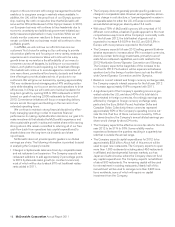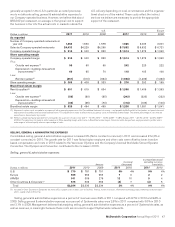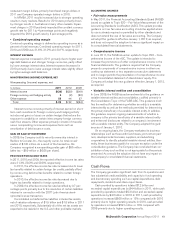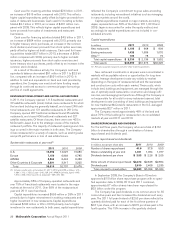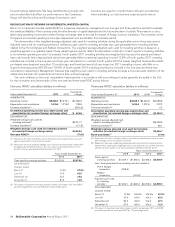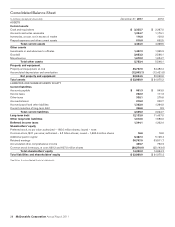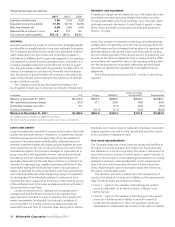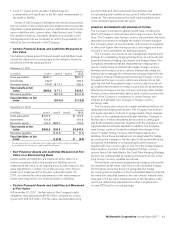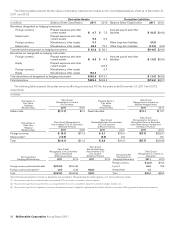McDonalds 2011 Annual Report Download - page 24
Download and view the complete annual report
Please find page 24 of the 2011 McDonalds annual report below. You can navigate through the pages in the report by either clicking on the pages listed below, or by using the keyword search tool below to find specific information within the annual report.
December 31, 2011, neither the Company nor its counterparties
were required to post collateral on any derivative position, other
than on hedges of certain of the Company’s supplemental benefit
plan liabilities where our counterparty was required to post
collateral on its liability position.
The Company’s net asset exposure is diversified among a
broad basket of currencies. The Company’s largest net asset
exposures (defined as foreign currency assets less foreign cur-
rency liabilities) at year end were as follows:
Foreign currency net asset exposures
In millions of U.S. Dollars 2011 2010
Euro $5,905 $5,465
Australian Dollars 2,409 2,075
Canadian Dollars 1,224 1,123
British Pounds Sterling 726 547
Russian Ruble 594 589
The Company prepared sensitivity analyses of its financial
instruments to determine the impact of hypothetical changes in
interest rates and foreign currency exchange rates on the
Company’s results of operations, cash flows and the fair value of
its financial instruments. The interest rate analysis assumed a
one percentage point adverse change in interest rates on all
financial instruments, but did not consider the effects of the
reduced level of economic activity that could exist in such an
environment. The foreign currency rate analysis assumed that
each foreign currency rate would change by 10% in the same
direction relative to the U.S. Dollar on all financial instruments;
however, the analysis did not include the potential impact on
revenues, local currency prices or the effect of fluctuating
currencies on the Company’s anticipated foreign currency royal-
ties and other payments received in the U.S. Based on the results
of these analyses of the Company’s financial instruments, neither
a one percentage point adverse change in interest rates from
2011 levels nor a 10% adverse change in foreign currency rates
from 2011 levels would materially affect the Company’s results
of operations, cash flows or the fair value of its financial
instruments.
CONTRACTUAL OBLIGATIONS AND COMMITMENTS
The Company has long-term contractual obligations primarily in
the form of lease obligations (related to both Company-operated
and franchised restaurants) and debt obligations. In addition, the
Company has long-term revenue and cash flow streams that
relate to its franchise arrangements. Cash provided by operations
(including cash provided by these franchise arrangements) along
with the Company’s borrowing capacity and other sources of
cash will be used to satisfy the obligations. The following table
summarizes the Company’s contractual obligations and their
aggregate maturities as well as future minimum rent payments
due to the Company under existing franchise arrangements as of
December 31, 2011. See discussions of cash flows and financial
position and capital resources as well as the Notes to the con-
solidated financial statements for further details.
Contractual cash outflows Contractual cash inflows
In millions Operating
leases Debt
obligations(1) Minimum rent under
franchise arrangements
2012 $ 1,247 $ 367 $ 2,425
2013 1,167 1,026 2,357
2014 1,075 738 2,273
2015 965 656 2,157
2016 852 2,158 2,037
Thereafter 6,248 7,499 15,949
Total $11,554 $12,444 $27,198
(1) The maturities reflect reclassifications of short-term obligations to long-term obliga-
tions of $1.5 billion, as they are supported by a long-term line of credit agreement
expiring in November 2016. Debt obligations do not include $56 million of noncash
fair value hedging adjustments or $218 million of accrued interest.
The Company maintains certain supplemental benefit plans
that allow participants to (i) make tax-deferred contributions and
(ii) receive Company-provided allocations that cannot be made
under the qualified benefit plans because of IRS limitations. At
December 31, 2011, total liabilities for the supplemental plans
were $482 million, and total liabilities for gross unrecognized tax
benefits were $565 million.
There are certain purchase commitments that are not recog-
nized in the consolidated financial statements and are primarily
related to construction, inventory, energy, marketing and other
service related arrangements that occur in the normal course of
business. The amounts related to these commitments are not
significant to the Company’s financial position. Such commit-
ments are generally shorter term in nature and will be funded
from operating cash flows.
Other Matters
CRITICAL ACCOUNTING POLICIES AND ESTIMATES
Management’s discussion and analysis of financial condition and
results of operations is based upon the Company’s consolidated
financial statements, which have been prepared in accordance
with accounting principles generally accepted in the U.S. The
preparation of these financial statements requires the Company
to make estimates and judgments that affect the reported
amounts of assets, liabilities, revenues and expenses as well as
related disclosures. On an ongoing basis, the Company evaluates
its estimates and judgments based on historical experience and
various other factors that are believed to be reasonable under the
circumstances. Actual results may differ from these estimates
under various assumptions or conditions.
The Company reviews its financial reporting and disclosure
practices and accounting policies quarterly to ensure that they
provide accurate and transparent information relative to the cur-
rent economic and business environment. The Company believes
that of its significant accounting policies, the following involve a
higher degree of judgment and/or complexity:
• Property and equipment
Property and equipment are depreciated or amortized on a
straight-line basis over their useful lives based on management’s
estimates of the period over which the assets will generate rev-
enue (not to exceed lease term plus options for leased property).
The useful lives are estimated based on historical experience with
22 McDonald’s Corporation Annual Report 2011


